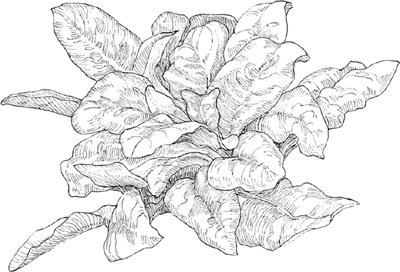
BOTANICAL NAME: Rumex acetosa
FAMILY: Polygonaceae

Sorrel is not one of those vegetables most likely to strike soaring sentiments in the hearts of poets, yet it has played an important role in Western cookery since the Middle Ages. Without Patience Dock, the dainty little Buckler-Leaf sorrel, and old-fashioned Osielle de Belleville (a variety de Combles mentioned in 1749 in his L’école du jardin potager), the cookery of eighteenth-century Europe would have been very dull indeed because sorrel was employed copiously in soups, green stocks, fish sauces, and salads intended to pique the appetite. The seeds were even used in medicine to treat bloody flux (dysentery). In other words, no kitchen garden was complete without it.
Today sorrel figures in many high-style recipes because its tart, lemony flavor was rediscovered during the 1970s as part of the movement now generally called nouvelle cuisine. We have since learned that this “nouvelle” cookery was in fact a return to old themes, and although the theories of this cooking style may be hashed and rehashed ad nauseum one of its happy side effects was the renewed attention given to old varieties of sorrel. Heirloom varieties like the golden Blonde de Lyon and the hardy narrowleafed Shchavel from Russia suddenly appeared on the most expensive menus. American chefs have not yet caught up with Osielle Sanguine, the rare French variety with red-tinged leaves and red veins—the rhubarb chard of the sorrel world—but they have discovered Profusion, and it is high time more people grew it.
Profusion sorrel has no precise age. It is the product of some strange mutation that took place in a remote corner of France, where it remained out of the scrutiny of horticulturists for many, many years. Samples were sent by a French customer to Richter’s Herbs of Goodwood, Ontario, in the late 1980s. The Richters recognized that this obscure type of sorrel had definite marketing possibilities, so they grew and selected plants for commercial release in 1993. What Richters received was a sorrel without name, described only as “non-flowering.” This nonflowering feature is critically important to cooks and kitchen gardeners alike.
Sorrel is generally treated as a spring and fall vegetable because warm weather causes it to bolt and flower. It is then bitter tasting and useless in the kitchen. Profusion never bolts. It is truly nonflowering, for it never produces flowers and therefore must be propagated by dividing the roots. Rather than running to seed, it simply produces fleshy lemony leaves all season long, even during droughts; thus it is a culinary dream come true. Since the plant grows in a tight mass, it is also a tidy potherb well suited for small gardens or as a border plant along paths.
The trick to cooking with it is to blend it with another potherb that is less acidic—chard is a perfect match. I was once challenged to create a sorrel sauce for poached plaice, a handsome orange-speckled fish resembling flounder. I combined Profusion sorrel with an abundance of fresh tarragon leaves, white wine, Noilly Prat, fish fond (from boiled shrimp skins), and a little lemon juice. Right at the end, after pureeing it all, I added a little crème fraîche. This went under the plaice, not on it. Little dices of potato served along the side acted as a perfect counter to the tartness of the sorrel sauce. Garnish? Try finely minced Zwollsche Krul celery (page 287). If this does not convince your guests that Profusion sorrel is just about the most elegant thing you can serve with fish, then tell them that in the old days sorrel was employed in cookery to temper the effervescence of coursing blood, to dampen the flames of fermenting gall, and to resist pestilential contagions induced by surfeits of plethoric heat. Permit this to sink in for a few moments; then return to your glass of wine comfortable in the knowledge that you have given them a good dish of food and certain peace of mind.